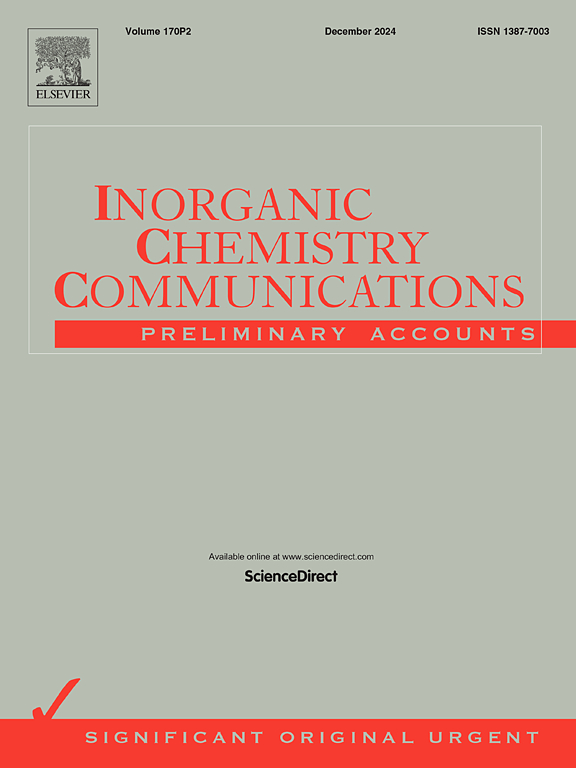Microwave-assisted continuous-flow preparation of magnetic composite MgFe2O4/UU-200 as efficient photocatalytic aqueous pollutant remediation
IF 4.4
3区 化学
Q1 CHEMISTRY, INORGANIC & NUCLEAR
引用次数: 0
Abstract
Current research aims to engineer sustainable and efficient materials for photocatalysis, which is still challenging in the industry. Magnesium ferrite (MgFe2O4) was incorporated into UU-200 frameworks under microwave-aided continuous flow, scalably producing hybrid MgFe2O4/UU-200 materials at 120 °C and within 10 min. The reaction yield reached approximately ∼74.5 %, and the production rate was ∼3.09 g/h. The nanocrystallites of MgFe2O4 were effectively incorporated into UU-200 frameworks during the reaction between Bi3+ ions and ligands, resulting in heterostructures with enhanced visible light absorption and magnetic properties. Under visible light irradiation, the sample prepared with a Bi3+/MgFe2O4 molar ratio of 2 exhibited the optimum photocatalytic removal efficiencies of ∼93 % for Cr6+ and ∼87% for Rhodamine B (RhB) from aqueous solutions, giving the highest photoreduction rates of 0.0124 min−1 and 0.0093 min−1, respectively. In addition, simultaneous decolourisation tests demonstrated that these structures effectively removed pollutants from the binary solution. The analyses revealed that photoinduced electrons photocatalytically reduced Cr6+ to Cr3+, while h+ and ![]() OH radicals predominantly drove the dye degradation. Notably, the produced MgFe2O4/UU-200 was rapidly isolated from the suspension solution using a magnet, thereby reducing its loss into the environment. The study presents an effective strategy for the scalable production of magnetic and visible-light-active MgFe2O4/UU-200 catalysts for photocatalytic water decontamination.
OH radicals predominantly drove the dye degradation. Notably, the produced MgFe2O4/UU-200 was rapidly isolated from the suspension solution using a magnet, thereby reducing its loss into the environment. The study presents an effective strategy for the scalable production of magnetic and visible-light-active MgFe2O4/UU-200 catalysts for photocatalytic water decontamination.
微波辅助连续流制备磁性复合材料MgFe2O4/UU-200作为光催化水中污染物的高效修复
目前的研究目标是设计可持续和高效的光催化材料,这在工业上仍然具有挑战性。在微波辅助连续流下,将铁素体镁(MgFe2O4)掺入UU-200框架中,在120 °C和10 min的条件下可大规模制备MgFe2O4/UU-200杂化材料。反应产率约为~ 74.5 %,产率为~ 3.09 g/h。在Bi3+离子与配体的反应过程中,MgFe2O4纳米晶被有效地结合到UU-200框架中,形成了具有增强可见光吸收和磁性能的异质结构。在可见光照射下,以Bi3+/MgFe2O4摩尔比为2制备的样品对水溶液中的Cr6+和Rhodamine B (RhB)的最佳光催化去除效率分别为~ 93 %和~ 87%,最高光还原率分别为0.0124 min−1和0.0093 min−1。此外,同时进行的脱色试验表明,这些结构有效地从二元溶液中去除污染物。结果表明,光诱导电子光催化Cr6+还原为Cr3+,而h+和OH自由基主要驱动染料降解。值得注意的是,生产的MgFe2O4/UU-200使用磁铁从悬浮溶液中快速分离,从而减少了其在环境中的损失。该研究提出了一种可扩展生产磁性和可见光活性MgFe2O4/UU-200光催化水净化催化剂的有效策略。
本文章由计算机程序翻译,如有差异,请以英文原文为准。
求助全文
约1分钟内获得全文
求助全文
来源期刊

Inorganic Chemistry Communications
化学-无机化学与核化学
CiteScore
5.50
自引率
7.90%
发文量
1013
审稿时长
53 days
期刊介绍:
Launched in January 1998, Inorganic Chemistry Communications is an international journal dedicated to the rapid publication of short communications in the major areas of inorganic, organometallic and supramolecular chemistry. Topics include synthetic and reaction chemistry, kinetics and mechanisms of reactions, bioinorganic chemistry, photochemistry and the use of metal and organometallic compounds in stoichiometric and catalytic synthesis or organic compounds.
 求助内容:
求助内容: 应助结果提醒方式:
应助结果提醒方式:


